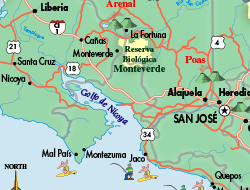Scientists rediscover The Isthmohyla Rivularis
The rarest tree frog, Isthmohyla rivularis, © Andrew Gray
Following the rediscovery of Isthmohyla rivularis, an exceedingly rare frog species long thought to be extinct, scientists have been able to study the possible effects of global warming on amphibian species around the world.
Unique Call
The last time anyone had seen Isthmohyla rivularis was in the mid-1980s, and scientists had written off the species in the two decades since then. That changed, however, in 2007, when a researcher from the University of Manchester discovered a solitary male in the Monteverde Cloud Forest Reserve during an expedition to work with a different variety of frog. The scientists and his colleagues were thrilled when they heard the frog's unique call, which they traced to its source - a tiny frog with brown and metallic green coloration. They were still worried, however, about the possibility that the male was the only remaining individual of his species.
More were Found
That changed just one year later, when another team found a small group of Isthmohyla rivularis frogs - including one female laden with eggs. Following the discovery of the inch-long specimens, herpetologists from the University of Manchester intensified their call for further study into the species' ecology and conservation.
When the scientists found the female frog, they used cotton swabs to collect tissue samples from her and her male companions. These were then tested for the presence of chytrid fungus, which creates a disease that has been cited as the likely reason for the extinction of many other local species.
Killing Fungus
The threat of chytrid fungus may actually be linked to global warming. Previously, frogs were able to sit out in the sun, the heat of which would kill any fungal spores present on their skin. Due to the effects of global warming, however, the amount of cloud cover over the Monteverde Cloud Forest Reserve has increased, impairing the frogs' ability to inoculate themselves against this deadly disease.
The survival of Isthmohyla rivularis has raised questions as to why this species stayed alive while others such as the golden toad were unable to do so. Accordingly, the scientists that discovered the female frog used a spectrometer to evaluate the animals' skin. The data they collected was ultimately used to determine whether the skin of Isthmohyla rivularis has any special properties that allow it to more effectively fight off the devastating effects of chytrid fungus.
7 Days / 6 Nights
Starting at $978 per person
10 Days / 9 Nights
Starting at $1,440 per person









.jpg)

.jpg)

.jpg)
.jpg)



